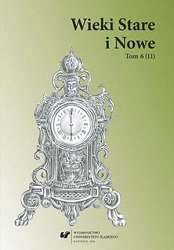Wizerunek barokowego sarmaty i oświeceniowego Europejczyka, czyli August III Wettyn i Stanisław August Poniatowski
Augustus III of Poland and Stanisław August Poniatowski. Picture of Baroque Sarmatist and Enlightened European
Author(s): Jerzy DygdałaSubject(s): History
Published by: Wydawnictwo Uniwersytetu Śląskiego
Summary/Abstract: In his propaganda King Augustus III of the House of Wettin made deliberate references to the Sarmatian tradition by way of showing himself in Polish attire just after coronation in Kraków on January 24th, his pilgrimage to Częstochowa to the shrine of Virgin Mary, gifts for the monastery, frequent attendance in Catholic religious rites, or hunting, the sovereign’s favourite pastime. Paintings by Louis de Silvestre depicting Augustus III and Princess Mary Josepha in Polish attire, favourable opinions about the King in Jerzy Kitowicz’s diaries and historical works by Jerzy Samuel Bandtkie played an important role as well. It was not until 1815 when the King’s recognition began to fade; under the influence of more recent historiography, negative opinions replaced positive ones. However, Stanisław August was often depicted as a European and cosmopolitan; he used to wear traditional Polish robes like żupan and kontusz only in his childhood. After that period he started to be seen in foreign costume (French). Numerous journeys abroad along with his upbringing by his insuperably ambitious and proud mother, Konstancja Czartoryska, shaped him mentally as a future king who displayed contempt towards the provincial nobility. The Convocation Sejm (1764) demanded that the future king wears Polish costume; however, Stanisław August Poniatowski presented medical certificates announcing the harmfulness of such vogue (due to the obligatory shaving of head) issued by seven doctors. King’s coronation attire (Spanish), is depicted in the painting by Marcell Bacciarelli. Most paintings and sketches present the King in French costume; nonetheless, there are works of art which portray the King in armour or garments alluding to antiquity, in army Cadet school uniform, Polish general uniform or everyday clothes (bekishe or nightgown). Later the King was also seen in English tailcoat. King Stanisław August emphasized the importance of breaking with degenerate Sarmatian tradition embedded in ideology and customs, as well as propagating the intellectual trends of the Enlightenment and new forms of everyday (the popularization of the “Monitor”, plays debunking the old Sarmatians, literary pieces promulgating new customs). Furthermore, Stanisław August was less ostentatious in his religious views, thus encouraged religious tolerance.
Journal: Wieki Stare i Nowe
- Issue Year: 11/2014
- Issue No: 6
- Page Range: 38-57
- Page Count: 20
- Language: Polish

